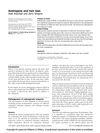Patients With a Large Prostate Show a Higher Prevalence of Androgenetic Alopecia
September 2005
in “
Archives of Dermatological Research
”

TLDR Large prostate patients more likely to have hair loss.
The study found that patients with a large prostate have a higher prevalence of androgenetic alopecia. The study defined BPH as having a prostate volume greater than 30 cm³, a maximal urine flow rate less than 15 ml/s, and a mean urine flow rate less than 10 ml/s, and a prostate-specific antigen less than 10 ng/ml. The study was conducted by researchers from various departments in Taiwan.






